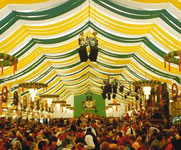Other highlights
Contact
Staatsbad Norderney GmbH
Weststrandstrasse 2
26548 Norderney
Email:
[email protected]
Internet:
www.norderney.de
Weststrandstrasse 2
26548 Norderney
Email:
[email protected]
Internet:
www.norderney.de
Nature & greenery

Observe one of nature's most fascinating phenomena where the Norderney coast meets the North Sea – the ebb and flow of the tides. Twice a day the waters of the North Sea flood the mudflats only to recede again. Tides are caused by the combined effect of the sun, the Earth and the moon on the water. At regular intervals of 12 hours and 25 minutes, the waters of the oceans and seas rise and fall up to 20 metres. The rhythm of people's lives living by the coast and on islands are also determined by the rise and fall of these tides.
Covering an area of over 8,000 square kilometres, the North Sea Wattenmeer mudflats are the largest on Earth. Mud deposits accumulate where waves and currents are slowed by offshore islands, sandbanks and extensive flat sea floors. A barefoot tour of the mudflats has to be experienced to be believed. However you should never go out onto the mudflats without an experienced guide. Even on the most beautiful of summer's days, inexperienced visitors may be at risk from suddenly descending fog or the rapidly rising tide.
The Lower Saxony Wattenmeer National Park – on Lower Saxony's North Sea coast in the north of Germany – offers protection to the Wattenmeer, the coastal area of mudflats between the Ems and Elbe rivers, as well as to the offshore East Frisian islands. Visitors here can experience amazing landscapes and stunning natural spectacles, such as the region's characteristic salt marshes, the steep sandy dunes near Dangast and the "floating bog" near Sehestedt, the last remaining outer dike bog in Germany. A great diversity of flora and fauna flourishes in the temperate environment of the Wattenmeer. This includes seals, which are best observed when on their sandbanks.
Travel Planner
Select an option...







